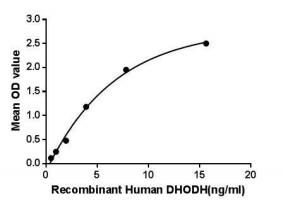50µg
Active Dihydroorotate Dehydrogenase (DHODH)
Organism Species: Homo sapiens (Human) Instruction manual
FOR RESEARCH USE ONLY
NOT FOR USE IN CLINICAL DIAGNOSTIC PROCEDURES
13th Edition (Revised in Aug, 2023)
[ PROPERTIES ]
Source: Prokaryotic expression.
Host: E. coli
Residues: Arg35~Asp392
Tags: N-terminal His-tag
Purity: >80%
Endotoxin Level: <1.0EU per 1μg (determined by the LAL method).
Buffer Formulation: PBS, pH7.4, containing 0.01% SKL, 5% Trehalose.
Original Concentration: 500µg/mL
Applications: Cell culture; Activity Assays.
(May be suitable for use in other assays to be determined by the end user.) Predicted isoelectric point: 9.5
Predicted Molecular Mass: 42.4kDa
Accurate Molecular Mass: 42kDa as determined by SDS-PAGE reducing conditions. [ USAGE ]
Reconstitute in 10mM PBS (pH7.4) to a concentration of 0.1-1.0 mg/mL. Do not vortex.
[ STORAGE AND STABILITY ]
Storage: Avoid repeated freeze/thaw cycles.
Store at 2-8oC for one month.
Aliquot and store at -80oC for 12 months.
Stability Test: The thermal stability is described by the loss rate. The loss rate
was determined by accelerated thermal degradation test, that is, incubate the protein at 37oC for 48h, and no obvious degradation and precipitation were observed. The loss rate is less than 5% within the expiration date under appropriate storage condition.
[ SEQUENCE ]

[ ACTIVITY ]
Dihydroorotate dehydrogenase (DHODH) is an enzyme which catalyzes the fourth enzymatic step, the ubiquinone-mediated oxidation of dihydroorotate to orotate, in de novo pyrimidine biosynthesis. This protein is a mitochondrial protein located on the outer surface of the inner mitochondrial membrane. As an enzyme associated with the electron transport chain, DHODH could link mitochondrial bioenergetics, cell proliferation, ROS production, and apoptosis in certain cell types. DHODH depletion also resulted in increased ROS production, decreased membrane potential and cell growth retardation. Besides, FK506 Binding Protein 8 (FKBP8) has been identified as an interactor of DHODH, thus a binding ELISA assay was conducted to detect the interaction of recombinant human DHODH and recombinant human FKBP8. Briefly, DHODH were diluted serially in PBS, with 0.01% BSA (pH 7.4). Duplicate samples of 100uL were then transferred to FKBP8-coated microtiter wells and incubated for 2h at 37℃ . Wells were washed with PBST and incubated for 1h with anti- DHODH pAb, then aspirated and washed 3 times. After incubation with HRP labelled secondary
antibody, wells were aspirated and washed 3 times. With the addition of substrate solution, wells were incubated 15-25 minutes at 37℃ . Finally, add 50µL stop solution to the wells and read at 450nm immediately. The binding activity of DHODH and FKBP8 was shown in Figure 1, and this effect was in a dose dependent manner.

[ IDENTIFICATION ]

Figure 2. Gene Sequencing (extract)